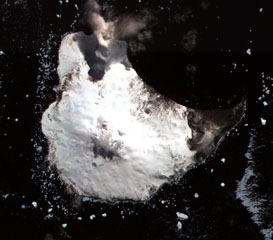Report on Saunders (United Kingdom) — April 2008
Bulletin of the Global Volcanism Network, vol. 33, no. 4 (April 2008)
Managing Editor: Richard Wunderman.
Saunders (United Kingdom) No thermal anomalies detected since December 2006
Please cite this report as:
Global Volcanism Program, 2008. Report on Saunders (United Kingdom) (Wunderman, R., ed.). Bulletin of the Global Volcanism Network, 33:4. Smithsonian Institution. https://doi.org/10.5479/si.GVP.BGVN200804-390090
Saunders
United Kingdom
57.8°S, 26.483°W; summit elev. 843 m
All times are local (unless otherwise noted)
The frigid, remote, and uninhabited region of Michael volcano is seldom visited. Thermal anomalies detected by satellite-based MODIS instruments, processed using the MODVOLC algorithm by the Thermal Alerts System of the Hawai'i Institute of Geophysics and Planetology, provide some data about possible eruptive activity (BGVN 28:02, 29:03, 31:04, and 31:10). During 3-6 October 2005 there were three days with thermal anomalies (BGVN 31:04). MODIS data indicates that anomalous pixels were also detected on 19 December 2005 (20 December UTC) and on 20 January 2006 (21 January UTC) (BGVN 31:10). The most recently reported MODIS thermal anomalies indicated activity during 19-21 October 2006 (20-21 October UTC) and again on 31 October-1 November 2006 (BGVN 31:10). The source of these anomalies was an inferred lava lake in a central vent as shown on an Advanced Spaceborne Thermal Emission and Reflection Radiometer (ASTER) image collected 28 October 2006 (BGVN 31:10). Additional anomalies occurred on 13 November and 6 December 2006 (7 December UTC). No anomalies were measured after that date through May 2008. Since August 2000 there have been six periods when thermal anomalies were detected in satellite imagery (table 2).
Table 2. Eruptive periods at Michael as inferred from MODIS thermal data from January 2000 through May 2008. Courtesy of the Hawai'i Institute of Geophysics and Planetology Thermal Alerts System.
| Date (UTC) | Thermal pixel data | Bulletin reference |
| 30 Aug 2000-03 Feb 2001 | 3 days with pixels | BGVN 28:02 |
| 05 Aug 2001-21 Nov 2001 | 10 days with pixels | BGVN 28:02 |
| 05 Jul 2002-01 Nov 2002 | 12 days with pixels | BGVN 28:02 |
| 07 May 2003 | 2 anomalous pixels | BGVN 29:03 |
| 03 Oct 2005-21 Jan 2006 | 5 days with pixels, three during 3-6 Oct | BGVN 31:04, 31:10 |
| 09 Jun 2006-07 Dec 2006 | 9 days with pixels | BGVN 31:10, 33:04 |
Geological Summary. Saunders Island consists of a large central volcanic edifice intersected by two seamount chains, as shown by bathymetric mapping (Leat et al., 2013). The young Mount Michael stratovolcano dominates the glacier-covered island, while two submarine plateaus, Harpers Bank and Saunders Bank, extend north. The symmetrical Michael has a 500-m-wide summit crater and a remnant of a somma rim to the SE. Tephra layers visible in ice cliffs surrounding the island are evidence of recent eruptions. Ash clouds were reported from the summit crater in 1819, and an effusive eruption was inferred to have occurred from a N-flank fissure around the end of the 19th century and beginning of the 20th century. A low ice-free lava platform, Blackstone Plain, is located on the north coast, surrounding a group of former sea stacks. A cluster of cones on the SE flank, the Ashen Hills, appear to have been modified since 1820 (LeMasurier and Thomson, 1990). Analysis of satellite imagery available since 1989 (Gray et al., 2019; MODVOLC) suggests frequent eruptive activity (when weather conditions allow), volcanic clouds, steam plumes, and thermal anomalies indicative of a persistent, or at least frequently active, lava lake in the summit crater. Due to this observational bias, there has been a presumption when defining eruptive periods that activity has been ongoing unless there is no evidence for at least 10 months.
Information Contacts: Hawai'i Institute of Geophysics and Planetology (HIGP) Thermal Alerts System, School of Ocean and Earth Science and Technology (SOEST), Univ. of Hawai'i, 2525 Correa Road, Honolulu, HI 96822, USA (URL: http://modis.higp.hawaii.edu/).

